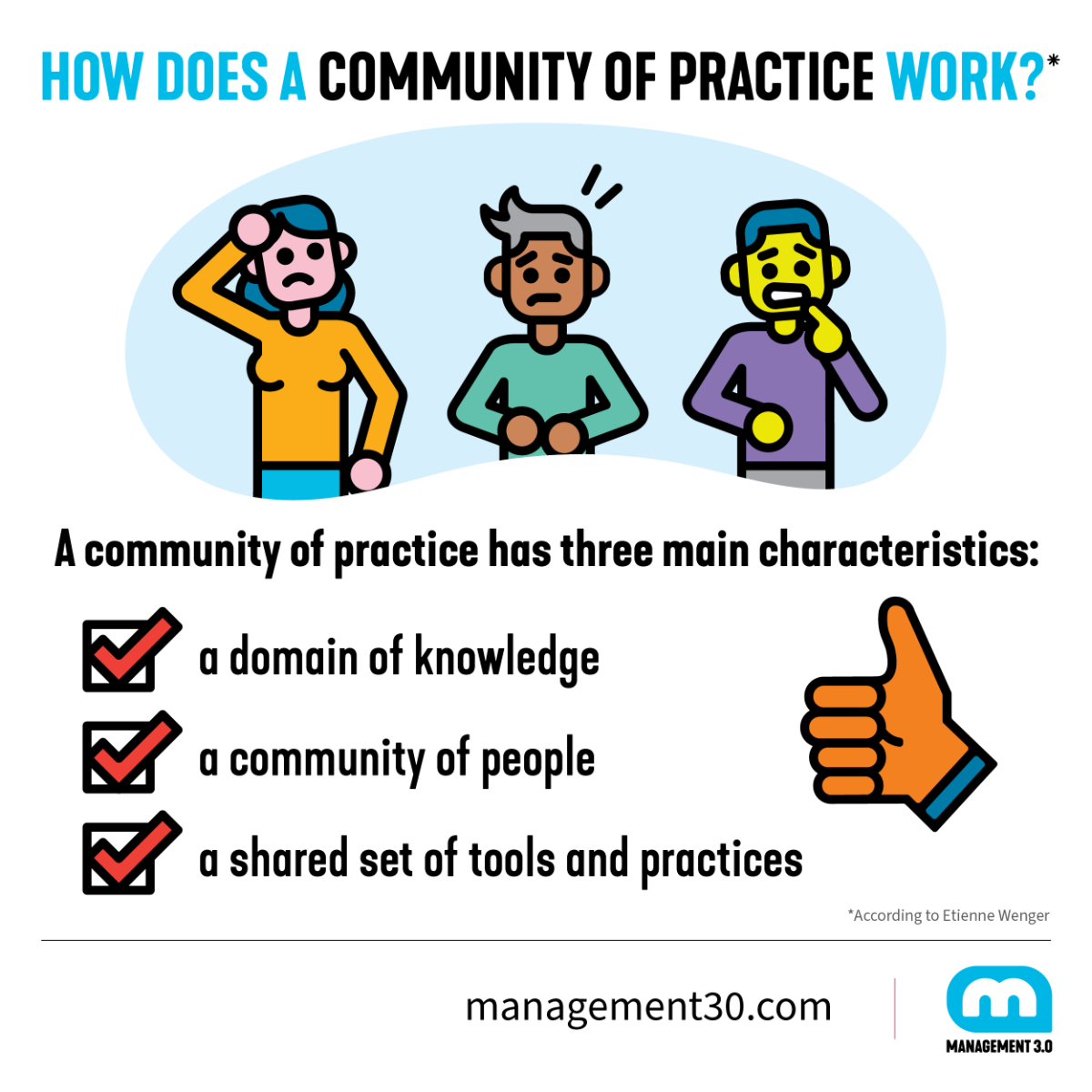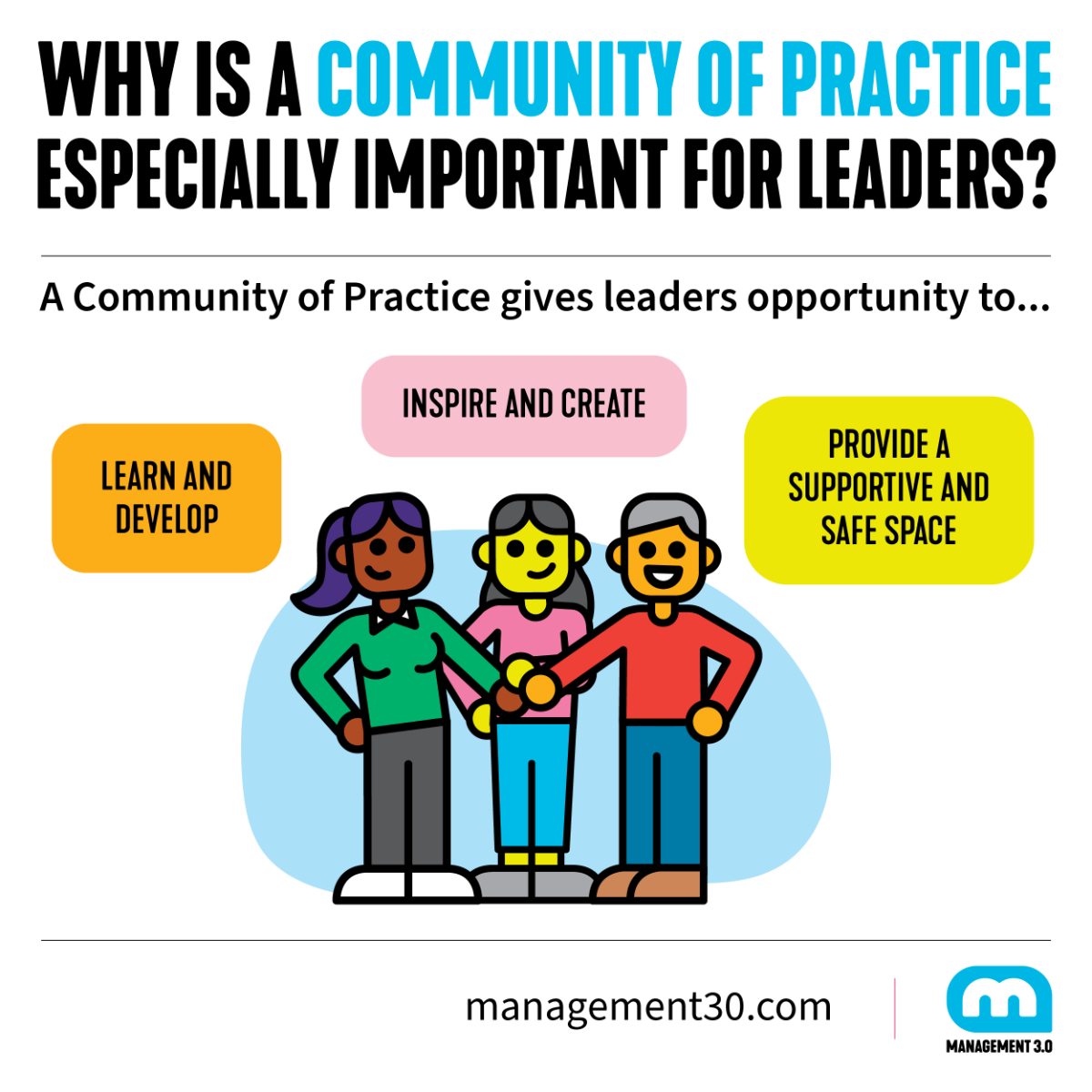An article by Sara Ramos, Management 3.0 Community Builder. Communities of Practice explained.
- What is a community of practice?
- How does a community of practice work?
- Types of community of practice
- Why is a community of practice especially important for leaders?
- What are the benefits of belonging to a community of practice?
- How do you start your own community of practice at work?
- How can communities of practice be integrated with formal learning and development initiatives?
Knowledge and practice are constantly evolving, though trying to keep up with the rapid pace of change without the help of others can be frustrating and isolating. Communities of Practice (CoP) allow members to share this journey and instead approach challenges collaboratively.
CoPs can be particularly valuable for leaders as the weight of responsibility and the need to make the right decisions are part of their job. In such circumstances, where can leaders turn to for support? This is where CoPs come into play, offering leaders opportunities for personal and professional development, inspiration, and emotional well-being.
In this article, we will cover what CoPs are, how they work, the different forms they may take, the benefits of belonging to one, and how to start your own.
Let’s dig in!

What is a community of practice?
A community of practice (CoP) is a group of people with a shared concern, interest or passion, who deepen their knowledge and expertise in this area by interacting on an ongoing basis.
E. Wenger, R. McDermott, W. Snyder
Communities of practice bring together individuals who share a common purpose and provide a space for voluntary, informal, and self-organized collaboration. They foster knowledge sharing, learning, and change by encouraging open communication, creative approaches, and the sharing of experiences and expertise. These characteristics enable CoPs to serve as vibrant learning ecosystems, driving personal and collective growth. Additionally, they can provide a sense of belonging and support for their members.
Communities of Practice at Management 3.0
We have included Communities of Practice in our list of practices under a different name: Business Guilds.
How does a community of practice work?
According to Etienne Wenger, a CoP has three main characteristics:
A domain of knowledge
CoPs are formed when a group realizes the need to learn from one another about a specific domain of knowledge, interest, or practice. This could be concerning anything from change management, to HR, to better leadership. This shared purpose provides a unifying focus and helps to define the boundaries of each community.
A community of people
Members contribute by sharing their knowledge, insights, and resources with others. They participate in discussions, ask questions, and seek advice from fellow community members. While there might be individuals with more expertise or experience, the emphasis is placed on creating an inclusive and supportive environment.
Community membership is voluntary, and there is not a fixed hierarchy. Leadership within the CoP may naturally emerge based on members’ contributions and influence. Members may come and go, and there is rarely a specific expectation of how much time they should invest in the community.
A shared set of tools and practices
CoPs thrive on regular interactions among members, but deciding how and how often they meet is up to them. These interactions can occur through various channels, such as face-to-face meetings, online platforms, social media groups, or via video conferencing. Regularly scheduled virtual and in-person meetings allow members to connect, learn from one another, and collaborate on tasks.
In short, a CoP works however its members want it to work, as long as there is a shared purpose and a group of motivated people who interact regularly.

Types of community of practice
Given the informal and emergent nature of CoPs, it is impossible to make a complete list of the types of communities that exist, but here is a starting point:
Role-based vs. topic-based
CoPs can bring together people with the same role (e.g., Agile Coaches) or gather anyone interested in a specific topic (e.g., Agile Leadership), independently of their formal role.
Organization-led vs. individuals-led
Organizations may take the initiative to create a CoP to advance the discussion and adoption of a specific idea (e.g., Management 3.0 Membership Community). Alternatively, any group of individuals can initiate a CoP to share experiences about the same topic (e.g., a group of coworkers who decide to start meeting regularly to share experiences on how they are using Management 3.0 practices in their organization).
Local vs. global
CoPs may emerge to connect people with similar interests in the same city or region (e.g., Portuguese Women in Tech) or to unite them across the globe (e.g., Management 3.0 Membership Community).
Fixed duration vs open-ended
At times, CoP exists only for a single large project. At other times, CoPs continue as long as their members are passionate about the shared purpose and are committed to keeping the community’s activities running.
I am sure there are many other forms a CoP can take. I would love to learn about more examples!
The primary difference between a Center of Excellence (CoE) and a Community of Practice (CoP) is that a CoE is often purposefully created by an organization with funded members whose full-time job is to coach, teach, and mentor people, whereas CoPs are voluntary efforts that typically aren’t funded.
Disciplined Agile, PMI
Why is a community of practice especially important for leaders?
A leadership role comes with responsibility and a certain pressure to do the right thing right. Who do leaders turn to for support?
CoPs can provide leaders opportunities for personal and professional development, inspiration, and emotional well-being. No matter how experienced they are, leaders must continue to learn and develop their mindsets, skillsets, and behaviors. Communities of practice can be valuable for learning new techniques, exchanging best practices, and gaining insights from peers in similar roles. These communities also provide opportunities for leaders to receive feedback on their ideas, reflect on their experiences, and identify areas for growth and improvement.
Additionally, communities of practice can be a source of inspiration and creativity for leaders seeking to stimulate innovation within their organizations. By engaging with peers from different backgrounds and industries, leaders can gain new perspectives and ideas that can be applied to their own work. These communities can also be a playground for exploring emerging trends that may impact their industry.
As commonly said, “It’s lonely at the top”; leadership can sometimes be a lonely and isolating journey. Communities of practice can also provide a supportive and safe space for leaders to share their doubts, questions, and challenges. By engaging with others who have faced similar experiences, leaders can gain valuable insights and support to help them navigate difficult situations and decisions.

How can I find and join a community of practice related to leadership?
Look for organizations or people dedicated to the specific topics you are interested in. We have the right space for you if you want to develop your Agile Leadership skills from a Management 3.0 lens!
What are the benefits of belonging to a community of practice?
Where to start?
Being part of any community is an opportunity to build connections outside your immediate circle, be it your team, organization, city, or country. This will expose you to the different realities and ways of thinking that bind groups together.
Community activities and interactions have the power to surface the collective intelligence of the group, which leads to numerous learning opportunities that you would not have access to on your own. And you will likely inspire and support someone else’s learning too! As a result, community members grow together.
As the saying goes: the journey is best when shared. Communities of any kind can contribute to the members’ well-being by providing a sense of belonging and support. After all, who doesn’t like to feel understood?
Communities of Practice in SAFe
Within SAFe, CoPs are essential in fostering continuous organizational learning and improvement. They provide a platform for practitioners to exchange ideas, best practices, and lessons learned, ultimately promoting knowledge sharing and increasing the overall expertise within the organization. CoPs can exist at various levels within a SAFe implementation, including team, program, and portfolio levels.
How do you start your own community of practice at work?
Well, the short answer is: do it! If you have a passion and a small group of people who share it, just do it. This is easy enough in theory, but here are some steps to put this into practice.
Before starting a new community of practice, take a step back and check if one already exists. Is there an existing group in your organization, city, or globally online? You may still want to create your own, but if you resonate with an already-formed community, why not tap into it?
If you feel the urge to have more like-minded people around you but are still determining what your shared topic could be, you may spot an opportunity in a number of places:
- Is there a specific technology or practice that you are passionate about?
- Have you recently attended an event and wanted to continue the conversation regularly?
- Are you itching to explore a new interest and could benefit from having others around?
- Could your organization benefit from more alignment around a particular topic?
Pick a topic and run with it!
If you decide to go ahead, find at least one other person who shares an interest in the topic and invite them for a first meeting. Remember: all you need to start a movement is a leader and the first follower.
Start by co-creating a working agreement and define how and when you will meet (you may also already include suggested ways of working or meeting in your invitation and then revisit these with the other members).
- Weekly Lunch & Learn?
- Monthly meeting with a co-created agenda, Lean Coffee-style?
- Sharing weekly wins on a Slack channel?
- Quarterly retreat?
Once you have established why and how you will gather, make an enticing invitation to other people who may be interested in joining you, if applicable. Do not be discouraged if only a small group joins at first; in communities, quality is far more important than quantity! Focus on inviting and encouraging the right people.
As you go along, make sure you stay open to how the CoP may evolve. Collect feedback and suggestions and adjust the activities to what best suits the members’ needs.

How can communities of practice be integrated with formal learning and development initiatives?
Formal moments of learning are fertile breeding grounds for the birth of CoPs. Remember that feeling after a fantastic workshop when you feel energized to keep learning and digging deeper? This is an excellent opportunity to ask your fellow learners if they want to meet regularly to keep evolving everyone’s understanding of the topic. These opportunities are crucial ways for learning to stick, as they encourage ongoing practice and reflection. A CoP facilitates this continued learning, inspiring accountability for everyone involved, and ensures that the time invested in the workshop does not go to waste.
When the topic at hand requires a mindset change, approaching this in isolation, (especially in a system that is not designed to reward it yet) can be extremely hard. Leaders are more likely to succeed if they surround themselves with people building the same mental muscles.
The Power of Communities of Practice
A community of practice is a group of individuals who come together voluntarily and informally to pursue a shared purpose, exchange knowledge, and foster learning and change.
If you are in a leadership position, having a CoP to rely on can be an essential source of support, continuous development, and well-being.
There are many types of CoPs, and the right one for you depends on your overall purpose and the goal that the community sets out to achieve. To start one of these communities, find at least one other person who shares a passion and start by reflecting on and defining why and how you would like to come together. After that, repetition and feedback gathering will be your best friends.
I hope this article clarified what, why, and how a community of practice can contribute to your professional and personal development.
If you are inspired to start or join a community, do it!
Header photo: Priscilla du Preez via Unsplash

